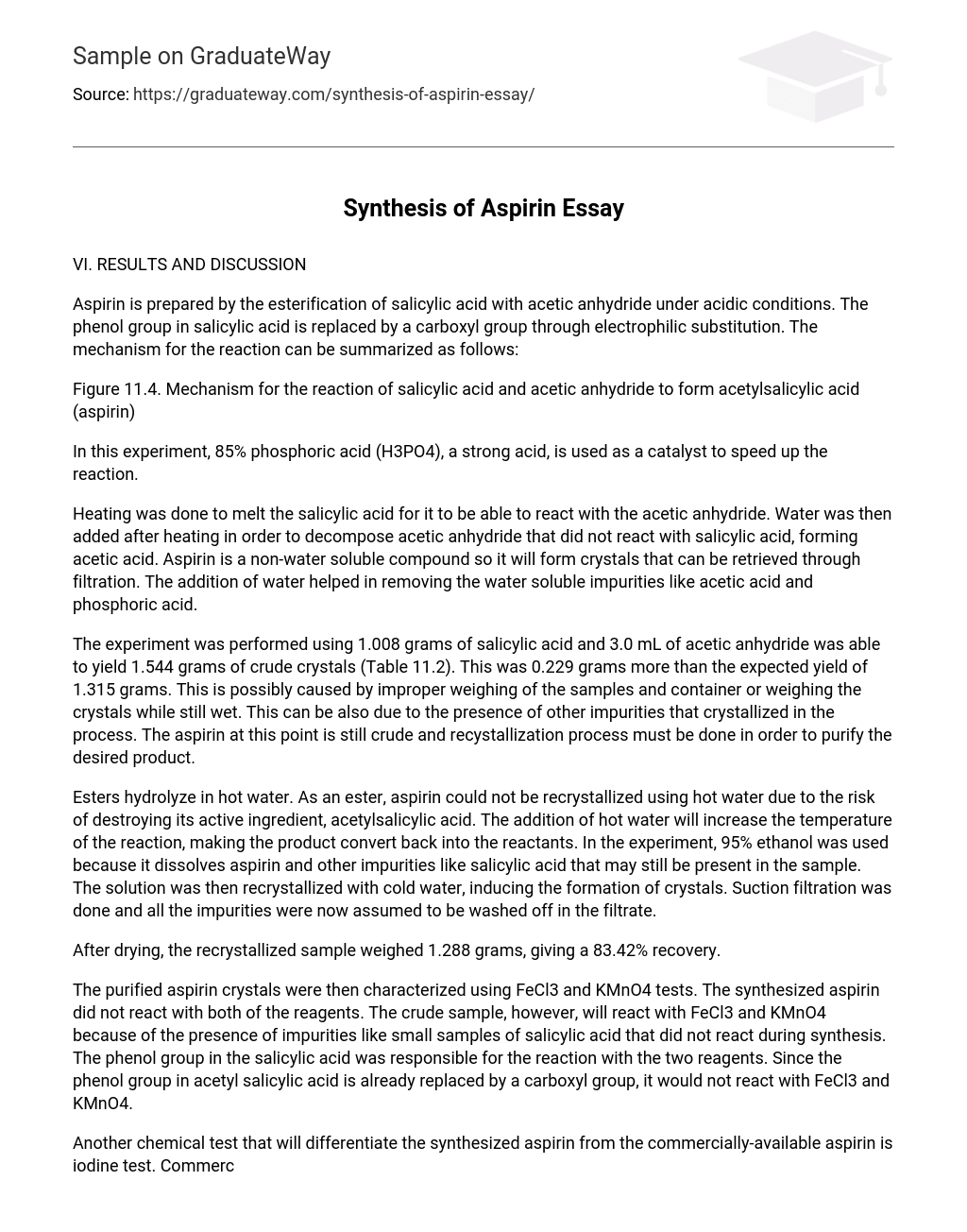VI. RESULTS AND DISCUSSION
Aspirin is prepared by the esterification of salicylic acid with acetic anhydride under acidic conditions. The phenol group in salicylic acid is replaced by a carboxyl group through electrophilic substitution. The mechanism for the reaction can be summarized as follows:
Figure 11.4. Mechanism for the reaction of salicylic acid and acetic anhydride to form acetylsalicylic acid (aspirin)
In this experiment, 85% phosphoric acid (H3PO4), a strong acid, is used as a catalyst to speed up the reaction.
Heating was done to melt the salicylic acid for it to be able to react with the acetic anhydride. Water was then added after heating in order to decompose acetic anhydride that did not react with salicylic acid, forming acetic acid. Aspirin is a non-water soluble compound so it will form crystals that can be retrieved through filtration. The addition of water helped in removing the water soluble impurities like acetic acid and phosphoric acid.
The experiment was performed using 1.008 grams of salicylic acid and 3.0 mL of acetic anhydride was able to yield 1.544 grams of crude crystals (Table 11.2). This was 0.229 grams more than the expected yield of 1.315 grams. This is possibly caused by improper weighing of the samples and container or weighing the crystals while still wet. This can be also due to the presence of other impurities that crystallized in the process. The aspirin at this point is still crude and recystallization process must be done in order to purify the desired product.
Esters hydrolyze in hot water. As an ester, aspirin could not be recrystallized using hot water due to the risk of destroying its active ingredient, acetylsalicylic acid. The addition of hot water will increase the temperature of the reaction, making the product convert back into the reactants. In the experiment, 95% ethanol was used because it dissolves aspirin and other impurities like salicylic acid that may still be present in the sample. The solution was then recrystallized with cold water, inducing the formation of crystals. Suction filtration was done and all the impurities were now assumed to be washed off in the filtrate.
After drying, the recrystallized sample weighed 1.288 grams, giving a 83.42% recovery.
The purified aspirin crystals were then characterized using FeCl3 and KMnO4 tests. The synthesized aspirin did not react with both of the reagents. The crude sample, however, will react with FeCl3 and KMnO4 because of the presence of impurities like small samples of salicylic acid that did not react during synthesis. The phenol group in the salicylic acid was responsible for the reaction with the two reagents. Since the phenol group in acetyl salicylic acid is already replaced by a carboxyl group, it would not react with FeCl3 and KMnO4.
Another chemical test that will differentiate the synthesized aspirin from the commercially-available aspirin is iodine test. Commercially-available aspirin has small amounts inert binding materials like starch, methylcellulose and microcrystalline cellulose (Pavia, 2005). The presence of starch in the commercially-available aspirin will react with the iodine solution, forming a dark blue complex. The synthesized aspirin, on the other hand, does not contain starch and will not react with iodine.
Based on the results of the chemical tests, it can be assumed that the synthesized product was indeed aspirin.
VII. SUMMARY AND CONCLUSION
In this experiment, aspirin was synthesized by reacting salicylic acid with acetic anhydride in the presence of a catalyst, phosphoric acid. The crude product was recrystallized using 95% ethanol and cold water in order to remove impurities like unreacted salicylic acid and acetic acid formed in the reaction. The purified product was then subjected to FeCl3 and KMnO4 tests, giving negative results. From the results of the experiment, it can be concluded that it was acetylsalicylic acid (aspirin) that was synthesized.
VIII. REFERENCES
Salicylic acid. (n.d.). Retrieved September 16, 2013 from http://en.m.wikipedia.org/ wiki/Salicylic_acid
Ethanol. (n.d.). Retrieved September 16, 2013 from http://en.m.wikipedia.org/wiki/Ethanol
Phosphoric acid. (n.d.). Retrieved September 16, 2013 from http://en.m.wikipedia.org/ wiki/Phosphoric_acid
Acetic anhydride. (n.d.). Retrieved September 16, 2013 from http://en.m.wikipedia.org/ wiki/Acetic_anhydride
Aspirin. (n.d.). Retrieved September 16, 2013 from http://en.m.wikipedia.org/wiki/Aspirin
The Synthesis of Aspirin. (n.d.). Retrieved September 19, 2013 from http://wwwchem.csustan.edu/consumer/aspirincons/aspirincons.htm
Aspirin. (n.d.). Retrieved September 16, 2013 from http://www.reference.com/ motif/health/aspirin-synthesis-balanced-equation
Whitten, K. W., R. E. Davis, M. L. Peck, G. G. Stanley (2007). Chemistry. 8th ed. USA: Thomson Brooks/Cole, p. 947.
Pavia, D. L., G. M. Lampman, G. S. Kriz, R. G. Engel (2005) Introduction to Organic Laboratory Techniques: A Small Scale Approace. USA: Thomson Brooks/Cole, p. 60. Accessed through: books.google.com.ph/books?isbn=0534408338
Aspirin MSDS. (n.d.). Retrieved September 19, 2013 from http://avogadro.chem. iastate.edu/MSDS/aspirin.htm
Salicylic acid MSDS. (n.d.). Retrieved September 19, 2013 from http://avogadro.chem. iastate.edu/MSDS/salicylic_acid.htm
Acetic anhydride MSDS. (n.d.). Retrieved September 19, 2013 from http://avogadro.chem. iastate.edu/MSDS/acetanhy.htm
Phosphoric acid MSDS. (n.d.). Retrieved September 19, 2013 from http://avogadro.chem. iastate.edu/MSDS/H3PO4.htm
Ethanol MSDS. (n.d.). Retrieved September 19, 2013 from http://avogadro.chem. iastate.edu/MSDS/ethanol.htm





